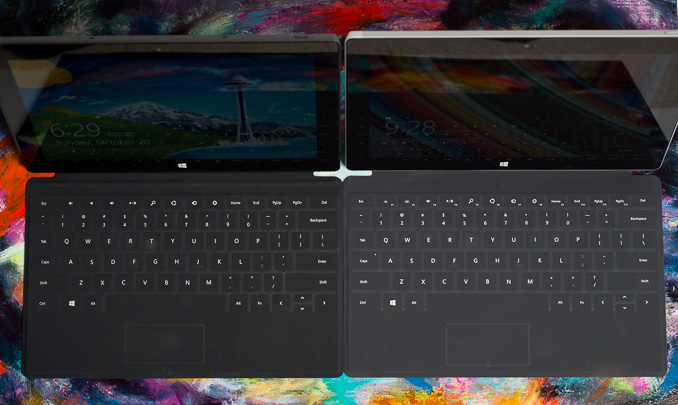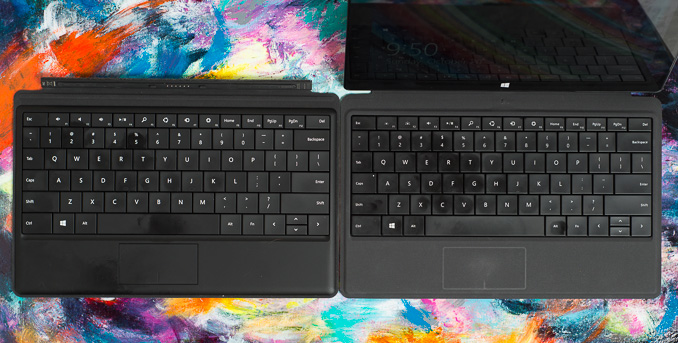Microsoft Surface 2 Review
by Anand Lal Shimpi on October 21, 2013 12:00 AM ESTThe New Touch/Type Covers
When I was first introduced to the folks who built Surface I was told about the three non-negotiable parts of its design: the tablet, the kickstand and the cover. While most tablet covers end up being protective accessories, the first party covers for Surface are an integral part of the overall experience.
Microsoft offers two cover options: the touch cover and the type cover. Both integrate full qwerty keyboards into a display cover that attached magnetically, but they differ in keyboard type. As its name implies, the touch cover integrates a pressure sensitive keyboard with no moving parts. By comparison, the type cover uses keys that physically move. Neither accessory is included with any Surface device and will set you back $119 for the touch cover and $129 for the type cover. They are expensive, but absolutely worth it if you’re going to do any sort of typing on your Surface.

Old (left) and new (right) touch covers
With the second generation of Surfaces, Microsoft improved both covers. They both get marginally thinner and backlit keys. The backlight effect is great, although there are only three keyboard backlight brightness levels.
The touch cover sees the biggest improvement as Microsoft moved from having only 80 pressure sensors in the previous design to 1092 sensors. The result is an incredible increase in accuracy. I find that I can type a lot lighter on the new touch cover and still have my keystrokes recognized. I also make far fewer mistakes on the new touch cover. While I felt that the initial touch cover was usable, this one is almost good enough to be a physical keyboard replacement.
| 2nd Generation Touch/Type Cover Thickness | ||||||||||
| Touch Cover | Type Cover | |||||||||
| 1st gen | 3.35 mm | 5.7 mm | ||||||||
| 2nd gen | 2.91 mm | 5.22 mm | ||||||||
| iPad 4 Smart Cover | 2.2 mm | |||||||||
Despite the tremendous improvement in accuracy on the new touch cover, I still prefer the type cover. I wrote long segments of this review on the new touch cover, but I had a much better time doing so on the type cover. Microsoft has reduced thickness on the new type cover, in part by reducing key travel. I’m happy to say that the reduction in key travel isn’t noticeable, and I’m able to type just as quickly and as comfortably as I could with the first gen type cover. The difference in thickness between the two is very small (~2.3mm) and you get a much more usable keyboard out of the type cover.

Old (left) and new (right) type covers
The new type cover ditches the clickpad in favor of a pressure sensitive trackpad. I’m a bit happier with the new trackpad but it’s still largely a pain to use for anything other than basic mousing. Two finger scrolling works ok, but any click and drag use is seriously frustrating thanks to the small size of the unit and no physical buttons. Thankfully there’s a 10.6-inch touchscreen a few inches away from you that works a lot better.
The new type cover ditches the felt backing of the previous model in favor of a soft touch plastic. Type covers are also now available in four colors (purple, pink, blue and black).
Remember that both of these covers make a physical connection to Surface, both to stay attached to the device as well as to transmit data. There’s no chance of running into spectrum crowding issues like you would with a 2.4GHz wireless keyboard, these keyboards are as good as any other wired device. The covers make a very strong magnetic connection to the device. The connection is strong enough to withstand picking up even a Surface Pro 2 by the attached cover and lightly swing it back and forth without the two separating. This is of course predicated on you properly attaching the cover to the tablet, but the strong magnets do a fairly good job of lining up and doing that as well.
The only issue I had with the new covers is that sometimes the trackpad would stop working after coming out of sleep. The keyboard worked fine, but the trackpad would just disappear. The only solution is to disconnect/reconnect the cover, which fixed it every time. I informed Microsoft about the issue, it’s something they’re aware of internally and plan to issue an update to fix.










139 Comments
View All Comments
Da W - Monday, October 21, 2013 - link
1- I use both MS and Google services on my surface (pro) and android phone (and dropbox). I do prefer MS bundle overall. I find also that its a generation thing, most aged 30-40Y tend to prefer MS while the younger generation tend to hate MS (and choose Google).2- Every google services, facebook, twiter, most "apps" are accessible in their internet version via ie11 and pinable on the start screen. In fact i think the lack of apps on the Windows store is a non-issue. On my android phone, i use mostly apps and almost never use the chrome browser. On my surface it's the opposite, i use almost no apps and do everything i need in the browser. (working in the browser is also the point of google chrome, so it's not a bas thing).
I think the # of app issue is overrated.
3- Agreed you can put Windows RT in the same class as google chrome, functionnality wise. That is: a limited OS that can't do what other mature OSes can.
Wolfpup - Thursday, October 31, 2013 - link
It is kind of Microsoft's version of a Chromebook, BUT it still does more. It still has local programs (even if you can only get them through the store). It still has much more of a real file system and has printer (and I think even scanner now?) support, etc.RannXeroxx - Friday, November 29, 2013 - link
Actually I think you have it wrong. Its people in their late 20s or mid 30s that seem to hate MS but younger people, just like they don't connect to the cold war or the fear of the USSR, they don't connect with the Microsoft Monopoly of the 90's and think of MS as XBox and WP8.prophet001 - Monday, October 21, 2013 - link
Good post sri_tech.hoboville - Monday, October 21, 2013 - link
Sorry, but that's an apples and oranges comparison. Chrome vs. Windows isn't the issue. It's Windows RT vs. Windows x86. With RT you get a gimped version of Windows that relies on the M$ Store for apps if you go with RT. If you go with Pro, you pay out the face for a device that is simply a super light, small touch-screened laptop. The great thing about Windows was that it could run a bajillion different x86 programs...not with RT though.Ok, so I'll pay $800 for a Pro? For $700, you can get a Haswell laptop with full x86 features (not gimped ARM derpness) on the Windows platform. You'll get the same battery life, a bigger screen, more storage space, the ability to upgrade, and more RAM. Don't forget the fact it has a real keyboard.
As Anand said: "When we first posted about ASUS’ T100, common feedback was that users would be willing to pay more for an even better device. A Bay Trail Surface 2 could’ve been that device." That's exactly my point, the RT could have waited 3-4 months ditched Tegra and gone to Bay Trail, which is extremely efficient, more powerful, and is x86. For $500 a full x86 tablet with Windows 8 would be a bombshell. It would have most of the features of a laptop while being a tablet. However, M$ is more concerned about roping people in to the M$ Store where they can cash out on apps BECAUSE the RT is a closed platform. They want you to get RT because it means they can milk you for most cash. If you want x86 they will charge you out the wazoo because they know once there, you can use any program you want.
trip1ex - Monday, October 21, 2013 - link
I don't think people want Windows x86 tablets. I think people want to ditch Windows. :)kyuu - Monday, October 21, 2013 - link
You're confusing "people" with "you".Why should I (or people) want to ditch Windows? What does iOS or Android offer that Windows doesn't? As far as I can tell it's nothing but a regression in features either way. OSX? I've used it and had the option for years. Still not interested. Linux? I can see the appeal, but again, I've used it and had the option for years. Nothing has changed that makes it more appealing than Windows for me or your average user.
ChromeOS? Don't make me laugh.
You want to avoid the malware situation that ignorant users get into on their Windows machines? Windows RT works for that. People who need more out of their OS than WinRT gives them should know enough to avoid malware in the first place.
Hrel - Friday, October 25, 2013 - link
He didn't say google apps were better, he said it depends on which apps you prefer.theduckofdeath - Wednesday, October 30, 2013 - link
Chrome OS does support touch screens. The Pixel has a touch ditto.And just because Microsoft has services, it is not unanimous with them being of equal quality. Personally, I find Google Docs to be more accessible despite the obvious lack of many features. There's no point in having an advanced online Office service, if it's not as simple to use.
thebeastie - Monday, October 21, 2013 - link
Looks pretty decent, I would feel good about recommending this to my clueless relatives who click and install every single web ad that pops up saying its going to "Improve system performance by %300" and installs garbage and maybe even something that attempts to rob them blind.With RT OS I feel assured that won't happen and they can sit and doodle in Office all day and be safe.